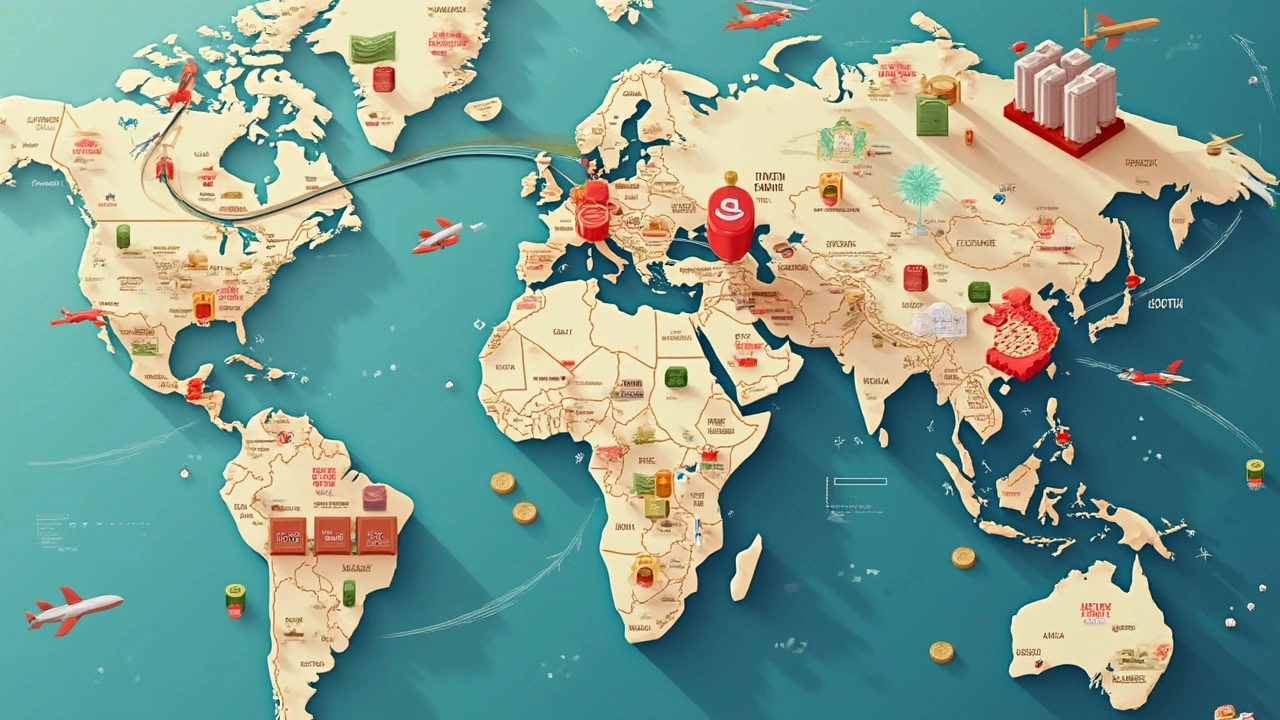Ever checked the price of sending something overseas and wondered if the package comes with gold bars? You’re not alone. International shipping charges can turn a regular order into a mini panic attack at checkout.
That crazy price isn’t just random. There’s a lot happening behind the scenes that stacks up fast: fuel, distance, customs paperwork, and plenty of surprise fees. And if you’re shipping during peak times or to a spot off the beaten path? Those numbers only climb higher.
The good news—there are ways to make sense of what you’re paying for and even knock down the bill a bit. Knowing what drives the costs means you’ll never feel ripped off by a shipping label again. Let’s break down exactly where your money’s going and what you can do about it.
- Breaking Down the Price Tag
- What Drives the Cost Up?
- Hidden Fees Most People Miss
- Saving Money When Shipping Internationally
Breaking Down the Price Tag
If you’ve ever looked at your international shipping receipt and scratched your head, you’re definitely not alone. The price isn’t a wild guess—every dollar on that bill comes from specific things that add up fast.
Let’s get real about what you’re actually paying for. First, there’s the obvious stuff like the fuel to fly, truck, or ship your package halfway around the globe. Did you know that long-haul flights burn through thousands of gallons of fuel just getting across the ocean? Fuel costs swing up and down, so when oil prices jump, so does your shipping rate.
Then there’s the distance factor. Sending something from New York to London doesn’t cost the same as shipping to a remote village in the Himalayas. The farther your stuff has to go, the more hands, trucks, and planes are involved—and each one takes a cut.
And don’t forget about weight and size. Carriers love light, small boxes and charge extra for heavy, bulky stuff. This is called “dimensional weight pricing.” If you send a big box of pillows, you’re paying for the space it eats up even though it’s light.
- Customs fees: These are government charges for moving goods across borders. It’s super common for people to miss these when estimating their costs.
- Insurance: If you want to play it safe and cover your package, that’s another extra.
- Handling and logistics: This covers sorting, scanning, and keeping your stuff moving. The more checkpoints, the higher the bill.
Here’s a quick look at what makes up your typical international shipping bill:
| Cost Element | Rough % of Shipping Bill |
|---|---|
| Transport (Fuel, Vehicles, Labor) | 40%-60% |
| Customs Fees & Taxes | 20%-30% |
| Insurance | 5%-10% |
| Handling/Logistics | 10%-20% |
So when you hit that “pay now” button, you’re really covering a whole team of people, a pile of paperwork, and a big journey across the world. Once you know where your money’s going, it’s a little less painful—or at least, less mysterious.
What Drives the Cost Up?
Let’s get into what actually causes those international shipping prices to jump. There’s no single reason—just a perfect storm of costs stacking up from every direction.
First, fuel is a big one. It costs a lot to move an airplane or cargo ship across the planet, and whenever oil prices go up, so does your shipping price. Shipping companies adjust their charges to stay profitable, and that difference ends up on your bill.
Next up: distance and speed. If your package is crossing continents, it’s going to cost more than shipping across town. Express services cost even more—think of it like paying extra for overnight pizza delivery, but at a global scale.
Regulations and paperwork pile on. Customs clearance isn’t free, and every country has its own rules. Carriers charge extra for filling out paperwork, dealing with import taxes, and sorting out different codes for your stuff. According to the World Bank, customs clearance and border controls can add up to 20% to shipping costs for small packages.
“Customs clearance delays are a major factor in higher shipping prices, especially with international e-commerce,” says the International Chamber of Commerce.
Then there’s size and weight. Heavier or bulkier items use more fuel and fill up the carrier’s space. That’s why a tiny but heavy box can sometimes cost more than a bigger, lighter one. Carriers use something called 'dimensional weight' calculations to squeeze the most money out of every square inch and kilogram.
| Factor | How It Impacts Cost |
|---|---|
| Fuel prices | Direct impact on surcharges |
| Distance | Longer trips cost more |
| Package size/weight | Heavy or large = higher price |
| Customs & Duties | Papework and taxes add up |
| Speed | Faster delivery increases cost |
Lastly, don’t forget rising labor costs and extra health safety measures since 2020. Workers, insurance, and extra cleaning have made logistics pricier. Plus, any disruptions—like strikes or wars—push prices up all over the globe almost instantly.
Bottom line: international shipping isn’t just about moving a box. Every checkpoint, layer of paperwork, and long stretch of ocean or air between you and your recipient adds dollars to the final bill.

Hidden Fees Most People Miss
It’s easy to get blindsided by the real cost of international shipping. You think you’ve paid it all with the main shipping fee, but a bunch of small charges sneak in after. If you’ve ever seen your total suddenly jump at checkout or got a surprise bill after your package arrives, you’ve come face-to-face with hidden shipping fees.
Here’s what usually falls through the cracks:
- Customs Duties and Taxes: Customs fees don’t show up until your package hits the border. Every country has its own rate. For example, the EU slaps on VAT (value-added tax) even for small items, and the US charges an import tax on stuff over $800.
- Customs Brokerage Fees: Companies like FedEx or DHL will handle customs paperwork, but don’t think that’s free. They charge a brokerage fee, which can range from a few bucks to over $50 depending on the value of your goods.
- Remote Area Surcharges: Delivering to out-of-the-way spots (think: rural towns, islands) usually means extra charges. Some carriers have a long (and weirdly specific) list of zip codes that add cash to the bill.
- Fuel Surcharges: When fuel prices spike, so does your shipping fee. Carriers often tack on fuel surcharges, which change monthly and can add 5%–20% to your bill without much warning.
- Security Fees: Airports and border points add small fees for extra screening, especially for express shipments or electronics. It’s usually just a few bucks, but it adds up.
- Disbursement Fees: When the carrier pays customs on your behalf and waits to get reimbursed, they’ll often charge you an extra percentage (usually 2%–3% of the paid amount) as a sort of ‘lending fee.’
If you’re curious how much these add up, here’s a quick look at common hidden charges for global freight based on some real 2024 averages:
| Hidden Fee Type | Average Cost (USD) |
|---|---|
| Customs Brokerage | $30 |
| Remote Area Surcharge | $25 |
| Fuel Surcharge | 8% of shipping cost |
| Security Fee | $5 |
| Disbursement Fee | 2%–3% of duties paid |
There’s no magic button to skip all these extra costs, but you can get ahead of them. Ask your courier or shipping partner for a breakdown of every possible charge before you ship. If you’re sending multiple packages abroad, see if you can bundle shipments or use a service where all fees are prepaid. That way, nothing gets lost in the fine print and you dodge the worst of the sticker shock.
Saving Money When Shipping Internationally
Alright, let’s get straight to it—everyone wants to pay less for international shipping. It sounds impossible, but trust me, there are a bunch of tricks most people overlook. You don’t have to sacrifice speed or take weird risks to shave off a chunk of that bill.
First thing—compare rates. Don’t just default to whatever shipping carrier pops up at checkout. UPS, FedEx, DHL, and national post services all set their own prices, and they bounce up and down depending on weight, size, and how quick you need the package delivered. Sites like Shippo and Easyship let you punch in your details and see price comparisons in seconds. That alone can save you 10-40% right out of the gate.
Package size matters—sometimes more than weight. Many carriers use “dimensional weight” for pricing, which basically means they charge you for the space your box takes up, not just what’s in it. So keep your packing tight and ditch oversized boxes. It’s wild, but even shaving a few inches can cut the fee by a third in some cases.
Group items together when possible. Sending two or three small boxes separately almost always costs more than stuffing everything safely into one medium box. Just double-check the package stays under the courier’s size and weight limits.
Take advantage of international shipping consolidators. These companies (like Stackry or MyUS) let you ship stuff to their warehouse in the destination country, then they recombine and send out everything together. You might have to wait a couple extra days, but this hack often makes expensive destinations feel way more affordable.
Watch out for sneaky add-ons. Signature confirmation, insurance, and "priority handling" sound nice, but bump up your costs fast. Only pay for what you actually need.
Be smart about customs forms and paperwork. If you fill these out wrong, your package can get stuck or sent back, and you get slapped with extra fees and delays. Double-check values, descriptions, and always include the right HS codes.
- Always check if the shipment qualifies as a 'Gift'—sometimes this reduces the import fee on the receiving end.
- If you're running a business, negotiate bulk discounts with your carrier. Even sending a couple of packages a month can earn you better rates over time.
- Keep an eye on shipping promos or free packaging offers from certain carriers.
Want some quick numbers? Here’s a real look at price differences for a 3 kg package going from New York to Paris in April 2025:
| Carrier | Economy (USD) | Express (USD) |
|---|---|---|
| DHL | $58 | $123 |
| FedEx | $62 | $136 |
| USPS | $49 | $110 |
Prices swing based on package details and when you’re sending, but comparison shopping and smarter packing could save you $30 or more per shipment. Those little choices stack up!





